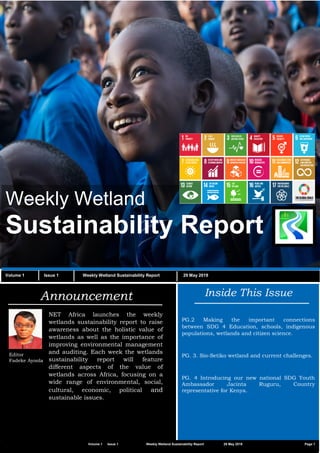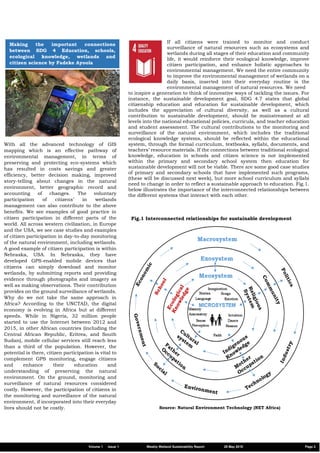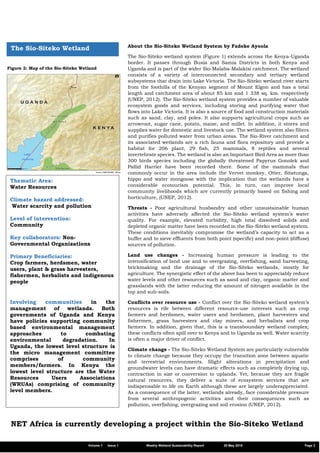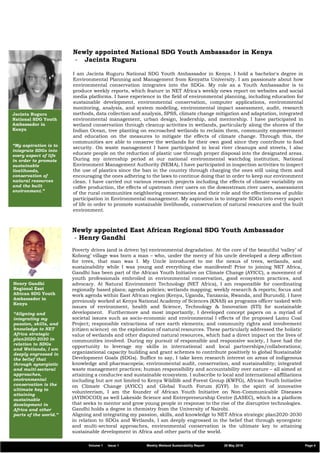Weekly Wetlands Sustainability Report - (June 5) NET Africa (www.netafrica.be)
- 1. Vvv Weekly Wetland Sustainability Report Volume 1 Issue 1 Weekly Wetland Sustainability Report 29 May 2019 Inside This Issue PG.2 Making the important connections between SDG 4 Education, schools, indigenous populations, wetlands and citizen science. PG. 3. Sio-Setiko wetland and current challenges. PG. 4 Introducing our new national SDG Youth Ambassador Jacinta Ruguru, Country representative for Kenya. Announcement Editor Fadeke Ayoola NET Africa launches the weekly wetlands sustainability report to raise awareness about the holistic value of wetlands as well as the importance of improving environmental management and auditing. Each week the wetlands sustainability report will feature different aspects of the value of wetlands across Africa, focusing on a wide range of environmental, social, cultural, economic, political and sustainable issues. Volume 1 Issue 1 Weekly Wetland Sustainability Report 29 May 2019 Page 1
- 2. With all the advanced technology of GIS mapping which is an effective pathway of environmental management, in terms of preserving and protecting eco-systems which has resulted in costs savings and greater efficiency, better decision making, improved story-telling about changes in the natural environment, better geographic record and accounting of changes. The voluntary participation of citizens’ in wetlands management can also contribute to the above benefits. We see examples of good practice in citizen participation in different parts of the world. All across western civilization, in Europe and the USA, we see case studies and examples of citizen participation in day-to-day monitoring of the natural environment, including wetlands. A good example of citizen participation is within Nebraska, USA. In Nebraska, they have developed GPS-enabled mobile devices that citizens can simply download and monitor wetlands, by submitting reports and providing evidence through photographs and imagery as well as making observations. Their contribution provides on the ground surveillance of wetlands. Why do we not take the same approach in Africa? According to the UNCTAD, the digital economy is evolving in Africa but at different speeds. While in Nigeria, 32 million people started to use the Internet between 2012 and 2015, in other African countries (including the Central African Republic, Eritrea, and South Sudan), mobile cellular services still reach less than a third of the population. However, the potential is there, citizen participation is vital to complement GPS monitoring, engage citizens and enhance their education and understanding of preserving the natural environment. On the ground, monitoring and surveillance of natural resources considered costly. However, the participation of citizens in the monitoring and surveillance of the natural environment, if incorporated into their everyday lives should not be costly. If all citizens were trained to monitor and conduct surveillance of natural resources such as ecosystems and wetlands during all stages of their education and community life, it would reinforce their ecological knowledge, improve citizen participation, and enhance holistic approaches to environmental management. We need the entire community to improve the environmental management of wetlands on a daily basis, inserted into their everyday routine is the environmental management of natural resources. We need to inspire a generation to think of innovative ways of tackling the issues. For instance, the sustainable development goal, SDG 4.7 states that global citizenship education and education for sustainable development, which includes the appreciation of cultural diversity, as well as a cultural contribution to sustainable development, should be mainstreamed at all levels into the national educational policies, curricula, and teacher education and student assessment. The cultural contributions to the monitoring and surveillance of the natural environment, which includes the traditional ecological knowledge systems, should be reflected within the educational system, through the formal curriculum, textbooks, syllabi, documents, and teachers’ resource materials. If the connections between traditional ecological knowledge, education in schools and citizen science is not implemented within the primary and secondary school system then education for sustainable development will not be viable. There are some good case studies of primary and secondary schools that have implemented such programs, (these will be discussed next week), but more school curriculum and syllabi need to change in order to reflect a sustainable approach to education. Fig.1. below illustrates the importance of the interconnected relationships between the different systems that interact with each other. Making the important connections between SDG 4 Education, schools, ecological knowledge, wetlands and citizen science by Fadeke Ayoola Fig.1 Interconnected relationships for sustainable development Source: Natural Environment Technology (NET Africa) Volume 1 Issue 1 Weekly Wetland Sustainability Report 29 May 2019 Page 2
- 3. Figure 2: Map of the Sio-Siteko Wetland The Sio-Siteko Wetland About the Sio-Siteko Wetland System by Fadeke Ayoola The Sio-Siteko wetland system (Figure 1) extends across the Kenya-Uganda border. It passes through Busia and Samia Districts in both Kenya and Uganda and is part of the wider Sio-Malaba-Malakisi catchment. The wetland consists of a variety of interconnected secondary and tertiary wetland subsystems that drain into Lake Victoria. The Sio-Siteko wetland river starts from the foothills of the Kenyan segment of Mount Elgon and has a total length and catchment area of about 85 km and 1 338 sq. km. respectively (UNEP, 2012). The Sio-Siteko wetland system provides a number of valuable ecosystem goods and services, including storing and purifying water that flows into Lake Victoria. It is also a source of food and construction materials such as sand, clay, and poles. It also supports agricultural crops such as arrowroot, sugar cane, potato, maize, and millet. In addition, it stores and supplies water for domestic and livestock use. The wetland system also filters and purifies polluted water from urban areas. The Sio-River catchment and its associated wetlands are a rich fauna and flora repository and provide a habitat for 206 plant, 29 fish, 25 mammals, 8 reptiles and several invertebrate species. The wetland is also an Important Bird Area as more than 300 birds species including the globally threatened Papyrus Gonolek and Pallid Harrier have been recorded there. Some of the mammals that commonly occur in the area include the Vervet monkey, Otter, Sitatunga, hippo and water mongoose with the implication that the wetlands have a considerable ecotourism potential. This, in turn, can improve local community livelihoods which are currently primarily based on fishing and horticulture, (UNEP, 2012). Threats - Poor agricultural husbandry and other unsustainable human activities have adversely affected the Sio-Siteko wetland system’s water quality. For example, elevated turbidity, high total dissolved solids and depleted organic matter have been recorded in the Sio-Siteko wetland system. These conditions inevitably compromise the wetland’s capacity to act as a buffer and to sieve effluents from both point (specific) and non-point (diffuse) sources of pollution. Land use changes - Increasing human pressure is leading to the intensification of land use and to overgrazing, overfishing, sand harvesting, brickmaking and the drainage of the Sio-Siteko wetlands, mostly for agriculture. The synergistic effect of the above has been to appreciably reduce water levels and other resources such as sand and clay, organic matter and grasslands with the latter reducing the amount of nitrogen available in the top and sub-soils. Conflicts over resource use - Conflict over the Sio-Siteko wetland system’s resources is rife between different resource-use interests such as crop farmers and herdsmen, water users and herdsmen, plant harvesters and fishermen, grass harvesters and clay miners, and herbalists and crop farmers. In addition, given that, this is a transboundary wetland complex; these conflicts often spill over to Kenya and to Uganda as well. Water scarcity is often a major driver of conflict. Climate change - The Sio-Siteko Wetland System are particularly vulnerable to climate change because they occupy the transition zone between aquatic and terrestrial environments. Slight alterations in precipitation and groundwater levels can have dramatic effects such as completely drying up, contraction in size or conversion to uplands. Yet, because they are fragile natural resources, they deliver a suite of ecosystem services that are indispensable to life on Earth although these are largely underappreciated. As a consequence of the latter, wetlands already, face considerable pressure from several anthropogenic activities and their consequences such as pollution, overfishing, overgrazing and soil erosion (UNEP, 2012). Thematic Area: Water Resources Climate hazard addressed: Water scarcity and pollution Level of intervention: Community Key collaborators: Non- Governmental Organizations Primary Beneficiaries: Crop farmers, herdsmen, water users, plant & grass harvesters, fishermen, herbalists and indigenous people Involving communities in the management of wetlands. Both governments of Uganda and Kenya have policies supporting community based environmental management approaches to combating environmental degradation. In Uganda, the lowest level structure is the micro management committee comprises of community members/farmers. In Kenya the lowest level structure are the Water Resources Users Associations (WRUAs) comprising of community level members. Volume 1 Issue 1 Weekly Wetland Sustainability Report 29 May 2019 Page 3 NET Africa is currently developing a project within the Sio-Siteko Wetland
- 4. Jacinta Ruguru National SDG Youth Ambassador in Kenya “My aspiration is to integrate SDGs into every aspect of life in order to promote sustainable livelihoods, conservation of natural resources and the built environment.” Newly appointed National SDG Youth Ambassador in Kenya - Jacinta Ruguru I am Jacinta Ruguru National SDG Youth Ambassador in Kenya. I hold a bachelor's degree in Environmental Planning and Management from Kenyatta University. I am passionate about how environmental conservation integrates into the SDGs. My role as a Youth Ambassador is to produce weekly reports, which feature in NET Africa's weekly news report on websites and social media platforms. I have experience in the field of environmental planning, including education for sustainable development, environmental conservation, computer applications, environmental monitoring, analysis, and system modeling, environmental impact assessment, audit, research methods, data collection and analysis, SPSS, climate change mitigation and adaptation, integrated environmental management, urban design, leadership, and mentorship. I have participated in wetland conservation through cleanup activities in wetlands, particularly along the shores of the Indian Ocean, tree planting on encroached wetlands to reclaim them, community empowerment and education on the measures to mitigate the effects of climate change. Through this, the communities are able to conserve the wetlands for their own good since they contribute to food security. On waste management I have participated in local river cleanups and streets, I also educate people on the reduction of plastic use through proper disposal into the designated areas. During my internship period at our national environmental watchdog institution, National Environment Management Authority (NEMA), I have participated in inspection activities to inspect the use of plastics since the ban in the country through charging the ones still using them and encouraging the ones adhering to the laws to continue doing that in order to keep our environment clean. I have carried out various research projects including the effects of climate variability on coffee production, the effects of upstream river users on the downstream river users, assessment of the rural communities neighboring conservancies and their role and the effectiveness of public participation in Environmental management. My aspiration is to integrate SDGs into every aspect of life in order to promote sustainable livelihoods, conservation of natural resources and the built environment. Newly appointed East African Regional SDG Youth Ambassador - Henry Gandhi Poverty drives (and is driven by) environmental degradation. At the core of the beautiful ‘valley’ of Kobong’ village was born a man – who, under the mercy of his uncle developed a deep affection for trees, that man was I. My Uncle introduced to me the nexus of trees, wetlands, and sustainability while I was young and everything else manifested! Prior to joining NET Africa, Gandhi has been part of the African Youth Initiative on Climate Change (AYICC), a movement of youth professionals embroiled in environmental conservation, good ecosystem practices, and advocacy. At Natural Environment Technology (NET Africa), I am responsible for coordinating regionally based plans; agenda policies; wetlands mapping; weekly research & reports; focus and work agenda within East African region (Kenya, Uganda, Tanzania, Rwanda, and Burundi). I have previously worked at Kenya National Academy of Sciences (KNAS) as programs officer tasked with issues of environment, health and Science, Technology & Innovation (STI) for sustainable development. Furthermore and most importantly, I developed concept papers on a myriad of societal issues such as socio-economic and environmental l effects of the proposed Lamu Coal Project; responsible extractions of rare earth elements; and community rights and involvement (citizen science) on the exploitation of natural resources. These particularly addressed the holistic value of wetlands and other disputed natural resources, which had a direct impact on the lives of communities involved. During my pursuit of responsible and responsive society, I have had the opportunity to leverage my skills in international and local partnerships/collaborations; organizational capacity building and grant schemes to contribute positively to global Sustainable Development Goals (SDGs). Suffice to say, I take keen research interest on areas of indigenous knowledge and pharmacopeia; environmental audit, conservation, and sustainability; integrated waste management practices; human responsibility and accountability over nature – all aimed at attaining a conducive and sustainable ecosystem. I subscribe to local and international affiliations including but are not limited to Kenya Wildlife and Forest Group (KWFG), African Youth Initiative on Climate Change (AYICC) and Global Youth Forum (GYF). In the spirit of innovative volunteerism, I am the founder of African Youth Initiative on Non-Communicable Diseases (AYINOCOD) as well Lakeside Science and Entrepreneurship Centre (LASEC), which is a platform that seeks to mentor and grow young people in response to the rise of the disruptive technologies. Gandhi holds a degree in chemistry from the University of Nairobi. Aligning and integrating my passion, skills, and knowledge to NET Africa strategic plan2020-2030 in relation to SDGs and Wetlands, I am deeply engrossed in the belief that through synergistic and multi-sectoral approaches, environmental conservation is the ultimate key to attaining sustainable development in Africa and other parts of the world. Henry Gandhi Regional East African SDG Youth Ambassador in Kenya “Aligning and integrating my passion, skills, and knowledge to NET Africa strategic plan2020-2030 in relation to SDGs and Wetlands, I am deeply engrossed in the belief that through synergistic and multi-sectoral approaches, environmental conservation is the ultimate key to attaining sustainable development in Africa and other parts of the world.” Volume 1 Issue 1 Weekly Wetland Sustainability Report 29 May 2019 Page 4




